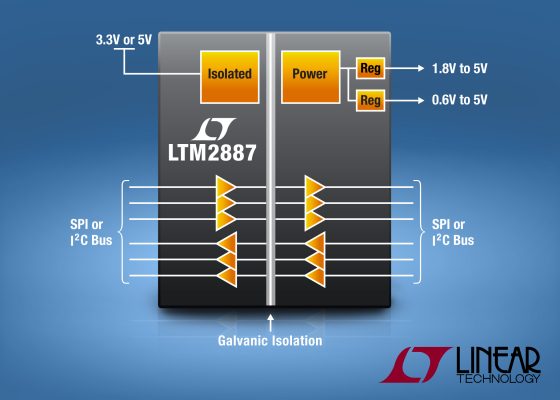Linear Technology Corporation introduces the LTM2887, a 6-channel SPI/Digital or I²C μModule® isolator with dual rail regulated power that targets low voltage components, including newer DSPs and microprocessors. Two well-regulated adjustable supply rails (up to 5V) deliver more than 100mA of load current over the isolation barrier, with up to 62% efficiency. The voltages may be adjusted as low as 0.6V for the auxiliary supply, while the isolated logic supply may be as low as 1.8V for SPI interfaces. Each supply provides a precise current limit adjustment pin and the ability to adjust the voltage using external resistors.
In industrial system applications, ground potentials can vary widely, often exceeding the tolerable range, interrupting communications or even destroying components. The LTM2887 breaks ground loops by electrically isolating the logic level interface on each side of an internal isolation barrier. This inductively coupled barrier withstands very large ground differential voltages up to 2,500VRMS.
A low EMI isolated DC/DC converter powers the LTM2887 and provides the isolated power to the communications interface and output rails. A separate logic supply pin provides direct interfacing with low voltage microcontrollers down to 1.62V, and an ON pin enables the LTM2887 to be shutdown and use less than 10μA. The LTM2887 provides uninterrupted communications for common mode transients greater than 30kV/μs and rugged ±10kV ESD (HBM) protection across the isolation barrier.
The LTM2887 is available in two communications interface versions. The LTM2887-I is I²C compliant at up to 400kHz with bidirectional serial data (SDA) plus clock (SCL) and three additional isolated CMOS logic signals that operate at up to 10MHz. The LTM2887-S is SPI-compliant and offers a total of six CMOS digital isolator communication channels. All channels operate at up to 10MHz and include three forward direction signals (CS, SCK and SDI) and three reverse direction signals (SDO, DO1 and DO2). When configured for SPI communications, the maximum clock rate is 8MHz for unidirectional communication or 4MHz for round-trip bidirectional operation.



















